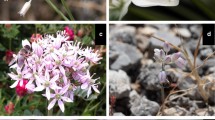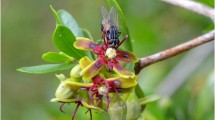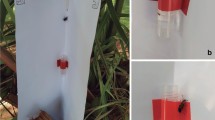Abstract
Two closely related forms ofOphrys insectifera were observed in the field to attract different pollinator species selectively.O. i. ssp.insectifera attracted males of two species ofArgogorytes (Sphecidae, Hymenoptera Aculeata) andO. i. ssp.aymoninii attractedAndrena combinata males (Andrenidae, Apoidea, Hymenoptera Aculeata). A third form,O. aff.i. ssp.insectifera, attracted none of these three species. Volatile compounds from flowers and inflorescences of the three forms (originating from Öland, Sweden, and Aveyron, France) were collected, using entrainment, enfleurage, and solvent extraction techniques, and identified by gas chromatography — mass spectrometry. Scent differences between the three forms were confirmed in the amounts of aliphatic hydrocarbons (C11–C19), methyl esters (C14–C18), short chain aliphatic 1-alcohols (C6–C12), and monoterpene alcohols (C10).
Similar content being viewed by others
References
Ågren L, Borg-Karlson A-K (1984) Responses ofArgogorytes (Hymenoptera: Sphecidae) males to odor signals fromOphrys insectifera (Orchidaceae). Preliminary EAG and chemical investigation. Nova Acta Reg Soc Sci Upsal Ser V:C3:111–117
Ågren L, Kullenberg B, Sensenbaugh T (1984) Congruences in pilosity between three species ofOphrys (Orchidaceae) and their hymenopteran pollinators. Nova Acta Reg Soc Sci Ser V:C3:15–25
Bergström G, Appelgren M, Borg-Karlson A-K, Groth I, Strömberg S, Strömberg S (1980) Studies of natural odiferous compounds. XXII. Techniques for the isolation/enrichment of plant volatiles in the analyses ofOphrys orchids (Orchidaceae). Chem Scr 16:173–180
Borg-Karlson A-K (1990) Chemical and ethological studies of pollination in the genusOphrys (Orchidaceae). Phytochemistry 29:1359–1387
Borg-Karlson A-K, Tengö J (1986) Odor mimetism? Key substances in theOphrys lutea/Andrena pollination relationship (Orchidaceae-Andrenidae). J Chem Ecol 25:1927–1941
Borg-Karlson A-K, Bergström G, Groth I (1985) Chemical basis for the relationship betweenOphrys orchids and their pollinators. I. Volatile compounds ofOphrys lutea andO. fusca as insect mimetic attractants/excitants. Chem Scr 25:283–294
Borg-Karlson A-K, Bergström G, Kullenberg B (1987) Chemical basis for the relationship betweenOphrys orchids and their pollinators. II. Volatile compounds ofO. insectifera andO. speculum as insect mimetic attractants/excitants. Chem Scr 27:303–311
Breistroffer M (1981) Notes succinctes sur quelques équivalences nomenclaturales d'espèces céveno/caussenardes et description d'une sous-espèce nouvelle d'Orchidée. Bull Soc Bot Fr 128:69–72
Kullenberg B (1950) Investigations on the pollination ofOphrys. Oikos 2:1–19
Kullenberg B (1952) Recherches sur la biologie florale desOphrys. Bull Soc Hist Nat Afr Nord 43:53–62
Kullenberg B (1956) Field experiments with chemical sexual attractants on aculeate Hymenoptera males. Zool Bidrag Uppsala 31:253–354
Kullenberg B (1961) Studies inOphrys pollination. Zool Bidrag Uppsala 34:1–340
Kullenberg B (1973) New observations on the pollination ofOphrys L. (Orchidaceae). Zoon Suppl. 1:9–14
Kullenberg B, Bergström G (1976) Hymenoptera Aculeata males as pollinators ofOphrys orchids. Zool Scr 5:13–23
Paulus HF, Gack C (1981) Neue Beobachtungen zur Bestäubungsbiologie (Pseudokopulation) verschiedener südspanischerOphrys-Arten unter besonderer Berücksichtigung des FormenkreisesO. fusca agg. Plant Syst Evol 137:241–258
Paulus HF, Gack C (1983) Untersuchungen desOphrys fusca-Formenkreises in Südspanien. Ein Beitrag zum Biospezieskonzept der GattungOphrys. Die Orchide, Sonderheft 1983:65–72
Tengö J (1979) Chemical signals and odour-released behaviour inAndrena bees (Hym., Andrenidae). Abstr Uppsala Diss Fac Sci 500:1–31
Warncke K, Kullenberg B (1984) Übersicht von Beobachtungen über Besuche vonAndrena- undColletes cunicularius-Männchen aufOphrys-Blüten (Orchidaceae). Nova Acta Reg Soc Sci Upsal Ser V:C3:41–55
Author information
Authors and Affiliations
Rights and permissions
About this article
Cite this article
Borg-Karlson, AK., Groth, I., Ågren, L. et al. Form-specific fragances fromOphrys insectifera L. (Orchidaceae) attract species of different pollinator genera. Evidence of sympatric speciation?. Chemoecology 4, 39–45 (1993). https://doi.org/10.1007/BF01245895
Issue Date:
DOI: https://doi.org/10.1007/BF01245895




